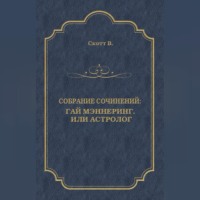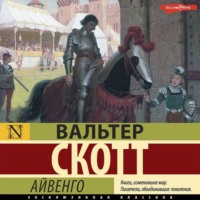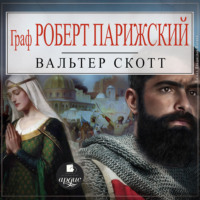 полная версия
полная версияMarmion

Walter Scott
Marmion: A Tale of Flodden Field in Six Cantos
EDITOR’S PREFACE
I. SCOTT AT ASHESTIELSir Walter Scott’s love of the country induced him, after his marriage in 1797, to settle in a cottage at the pretty village of Lasswade, near Edinburgh. Four years after leaving this district he took Mr. Morritt of Rokeby to see the little dwelling, telling him that, though not worth looking at, ‘it was our first house when newly married, and many a contrivance it had to make it comfortable.’ He then enumerated various devices, by which he had secured for Mrs. Scott and himself what seemed to both, at the time, additional convenience and elegance in and about their home. His reminiscences culminated in an account of an arch over the gate-way, which he had constructed by fastening together the tops of two convenient willows and placing above them ‘a cross made of two sticks.’ This is very beautiful and characteristic; and there is much freshness and charm in the further picture of the young cottagers rejoicing over the success of the arrangements. ‘To be sure,’ Scott concluded, ‘it is not much of a lion to show a stranger; but I wanted to see it again myself, for I assure you after I constructed it, Mamma (Mrs. Scott) and I both of us thought it so fine, we turned out to see it by moonlight, and walked backwards from it to the cottage-door in admiration of our own magnificence and its picturesque effect.’ It was his way to invest his circumstances with an interest over and above what intrinsically belonged to them, and to prompt his friends to a share in his delight.
When, in 1804, Scott was appointed Sheriff of Selkirkshire, a condition attaching to his post was that he should reside during part of the year within the bounds of his sheriffdom. He then removed from Lasswade, and settled at Ashestiel on the Tweed, seven miles from Selkirk. This is his own account of the new home: -
‘We found a delightful retirement, by my becoming the tenant of my intimate friend and cousin-german, Colonel Russell, in his mansion of Ashestiel, which was unoccupied during his absence on military service in India. The house was adequate to our accommodation, and the exercise of a limited hospitality. The situation is uncommonly beautiful, by the side of a fine river, whose streams are there very favourable for angling, surrounded by the remains of natural woods, and by hills abounding in game. In point of society, according to the heartfelt phrase of Scripture, we dwelt “amongst our own people”; and as the distance from the metropolis was only thirty miles, we were not out of reach of our Edinburgh friends, in which city we spent the terms of the summer and winter Sessions of the Court, that is, five or six months in the year.’
The functions of the Sheriff of Selkirkshire admitted of considerable leisure, and Scott settled at Ashestiel full of literary projects, as well as heartily prepared to meet his new responsibilities and to add to his numerous and valuable friendships. An enterprise that early engaged his attention was a complete edition of the British poets, but the deliberations on the subject came to nothing except in so far as they helped towards the preparation of Campbell’s ‘Specimens of the British Poets,’ which appeared in 1819. Writing Scott regarding his project of a complete edition of the poets, his friend George Ellis said, ‘Much as I wish for a corpus poetarum, edited as you would edit it, I should like still better another Minstrel Lay by the last and best Minstrel; and the general demand for the poem seems to prove that the public are of my opinion.’ The work of editing, however, he seemed at the time determined on having, and he finally abandoned the idea of an exhaustive issue of the British poetry previous to his own time and settled down to edit Dryden. This was a work much needed, and Scott did it extremely well, as may be seen by comparing his own issue of Dryden’s Life and Works in 1808 with the recent reproduction of it, admirably edited by Mr. George Saintsbury.
He had likewise, as he mentions in the General Preface to the Novels, begun Waverley ‘about 1805,’ and other literary engagements received their share of attention. He wrote articles for the Edinburgh Review, besides doing such minor if useful literary service as editing for Constable ‘Original Memoirs written during the Great Civil Wars,’ and so on. At the same time, there were prospects of professional advancement, an account of which he gives in the following terms, in the 1830 Introduction to ‘Marmion’: -
‘An important circumstance had, about the same time, taken place in my life. Hopes had been held out to me from an influential quarter, of a nature to relieve me from the anxiety which I must have otherwise felt, as one upon the precarious tenure of whose own life rested the principal prospects of his family, and especially as one who had necessarily some dependence upon the favour of the public, which is proverbially capricious; though it is but justice to add, that, in my own case, I have not found it so. Mr. Pitt had expressed a wish to my personal friend, the Right Hon. William Dundas, now Lord Clerk Register of Scotland, that some fitting opportunity should be taken to be of service to me; and as my views and wishes pointed to a future rather than an immediate provision, an opportunity of accomplishing this was soon found. One of the Principal Clerks of Session, as they are called, (official persons who occupy an important and responsible situation, and enjoy a considerable income,) who had served upwards of thirty years, felt himself, from age, and the infirmity of deafness with which it was accompanied, desirous of retiring from his official situation. As the law then stood, such official persons were entitled to bargain with their successors, either for a sum of money, which was usually a considerable one, or for an interest in the emoluments of the office during their life. My predecessor, whose services had been unusually meritorious, stipulated for the emoluments of his office during his life, while I should enjoy the survivorship, on the condition that I discharged the duties of the office in the meantime. Mr. Pitt, however, having died in the interval, his administration was dissolved, and was succeeded by that known by the name of the Fox and Grenville Ministry. My affair was so far completed, that my commission lay in the office subscribed by his Majesty; but, from hurry or mistake, the interest of my predecessor was not expressed in it, as had been usual in such cases. Although, therefore, it only required payment of the fees, I could not in honour take out the commission in the present state, since, in the event of my dying before him, the gentleman whom I succeeded must have lost the vested interest which he had stipulated to retain. I had the honour of an interview with Earl Spencer on the subject, and he, in the most handsome manner, gave directions that the commission should issue as originally intended; adding, that the matter having received the royal assent, he regarded only as a claim of justice what he would have willingly done as an act of favour. I never saw Mr. Fox on this, or on any other occasion, and never made any application to him, conceiving that in doing so I might have been supposed to express political opinions contrary to those which I had always professed. In his private capacity, there is no man to whom I would have been more proud to owe an obligation, had I been so distinguished.
‘By this arrangement I obtained the survivorship of an office, the emoluments of which were fully adequate to my wishes; and as the law respecting the mode of providing for superannuated officers was, about five or six years after, altered from that which admitted the arrangement of assistant and successor, my colleague very handsomely took the opportunity of the alteration, to accept of the retiring annuity provided in such cases, and admitted me to the full benefit of the office.’
At Ashestiel Scott systematically planned his day. He had his mornings for his multifarious work, and the after part of the day was given to necessary recreation and to his friends. He was an ardent member of the Edinburgh Light Horse, at a time when volunteers of a practical and energetic character seemed likely to be needed, and at Ashestiel he combined a certain military routine with his legal and literary arrangements. James Skene of Rubislaw, one of his best friends and most frequent visitors, mentions that ‘before beginning his desk-work in the morning he uniformly visited his favourite steed, and neither Captain nor Lieutenant, nor the Lieutenant’s successor, Brown Adam (so called after one of the heroes of the Minstrelsy), liked to be fed except by him.’ Skene is the friend to whom Scott addresses the Introduction to Canto IV, charged with touching and beautiful reminiscences of earlier days. They were comrades in the Edinburgh Light Horse Volunteers, Scott being Quartermaster and Skene Cornet. Their friendship had been one of eleven years’ standing when the dedicatory epistle was written: -
‘Eleven years we now may tell, Since we have known each other well; Since, riding side by side, our hand First drew the voluntary brand.’With regard to the Introductions, it may now be said that they are better where they are than if the poet had published them separately, as at one time he seems to have intended (see Notes, p. 187). It is sometimes said by those anxious to learn the story that these introductory Epistles should be steadily ignored, and the cantos read in strict succession. In answer to an assertion of opinion like this, it is hardly necessary to say more than that probably those interested in the narrative alone could not do better than avoid the Introductions. But it will be well for them to miss various other things besides: will they, for example, care for the impassioned address of Constance to her judges, for the landlord’s tale of grammarye, for Sir David Lyndsay’s narrative, or even for the many descriptive passages that interrupt the free progress of the tale? Their reading would appear to be done on the plan of those who get through novels, or other works of imagination, by carefully omitting the dialogue and all those passages in which the author pauses to describe or to reflect. It is needless to say that this is not the spirit in which to approach ‘Marmion’ as it stands. Scott wrote with his friends about him, and it was part of his own enjoyment of his work to interest them in what for the time was receiving the main part of his attention. His talk with Mr. Morritt in front of the little cottage at Lasswade is highly significant as illustrative of his attitude towards his friends. His healthy, humorous, happy nature wanted sympathy, appreciation, sociality, and good cheer for its complete normal development, and this alone would explain the writing of the Introductions. But there is more than this. He talked over his subject and his progress with friends competent to discuss and advise, and he showed them portions of the poem as he advanced. There are indications in the Introductions of certain discussions that had arisen over his conception and treatment, and surely few readers would like to miss from the volume the clever and humorous apology for his own method which the poet advances in the Introduction to the third canto. William Erskine, refined critic and life-long friend, is asked to be patient and generous while the poet proceeds in his own way: -
‘Still kind, as is thy wont, attend, And in the minstrel spare the friend, Though wild as cloud, as stream, as gale, Flow forth, flow unrestrain’d, my Tale!’Further, the Introductions do not in any case interrupt the progress of the Poem. Scott was dealing with a great national theme-a cause he and his friends could understand and appreciate-and both before starting and at every pause he has something to say that is apposite and suggestive. His country’s wintry state is the key-note of the first Introduction, which is an appropriate prelude to a great national tragedy; weird Border legends and the touching and mysterious silences of lone St. Mary’s Lake fitly introduce the ‘mysterious Man of Woe’; the third and the fourth Introductions, with their features of personal interest and their bright reminiscences of ‘tales that charmed’ and scenes on ‘the field-day, or the drill,’ are easily connected with the Hostel and the Camp; Spenser’s ‘wandering Squire of Dames,’ the vigorous description of the ‘Queen of the North,’ and the tribute to the notes that ‘Marie translated, Blondel sung,’ all tell in their due place as preparatory to the canto on The Court; while the ominous record, emanating from a Yule-tide retreat, could not be more fitly interrupted than by a battle of national disaster. Scott, then, may have thought of publishing the Introductions separately, but it is well that he ultimately allowed his better judgment to prevail. It is not necessary to dwell on their special descriptive features, which readily assert themselves and give Scott a high and honoured place among Nature-poets. His quick and minute observation, his sense of colour and harmonious effects, and his skill of arrangement are admirable throughout.
II. COMPOSITION OF ‘MARMION’In 1791 Scott accompanied an uncle into Northumberland, and made his first acquaintance with the scene of Flodden. Writing to his friend William Clerk (Lockhart’s Life, ii. 182), he says, ‘Never was an affair more completely bungled than that day’s work was. Suppose one army posted upon the face of a hill, and secured by high grounds projecting on each flank, with the river Till in front, a deep and still river, winding through a very extensive valley called Milfield Plain, and the only passage over it by a narrow bridge, which the Scots artillery, from the hill, could in a moment have demolished. Add that the English must have hazarded a battle while their troops, which were tumultuously levied, remained together; and that the Scots, behind whom the country was open to Scotland, had nothing to do but to wait for the attack as they were posted. Yet did two-thirds of the army, actuated by the perfervidum ingenium Scotorum, rush down and give an opportunity to Stanley to occupy the ground they had quitted, by coming over the shoulder of the hill, while the other third, under Lord Home, kept their ground, and having seen their King and about 10,000 of their countrymen cut to pieces, retired into Scotland without loss.’ Fifteen years after this was written Scott began the composition of ‘Marmion,’ and it is interesting to note that, so early in life as the date of this letter indicates, he was so keenly alive to the great blunder in military tactics made by James IV and his advisers, and so manifestly stirred to eloquent expression of his feeling.
In November 1806 Scott began ‘Marmion,’ designed as a romance of Feudalism to succeed the Border study in ‘The Lay of the Last Minstrel.’ The circumstances of the time, no doubt, to some extent prompted the choice of subject. Napoleon was diligently working out his ambitious scheme of a Western Empire, and plotting the ruin of Great Britain as an indispensable feature of the arrangement. Scott was not always intimately acquainted with the details of current politics, but when a subject fairly roused his interest he was not slow to take part in its discussion. This is notably illustrated, in this very year 1806, by the outspoken and energetic political ballad he produced over the acquittal of Lord Melville from a serious charge. This ballad, which went very straight to the heart of its subject, and left no doubt as to the party feeling of the writer, not only arrested general attention but gave considerable offence to the leaders on the side so sharply handled. It is given, with an explanation of the circumstances that called it forth, in Lockhart’s Life, ii. 106, 1837 ed.
While, however, party politics was not always a subject that interested Scott, patriotism was a constituent element of his character. He had a keen sense of national dignity and honour-as the extract from his Flodden letter alone sufficiently testifies-and, had circumstances demanded it of him, he would almost certainly have distinguished himself as a trooper on the field of battle. Thus it was not only his love of a picturesque theme that inspired him with his Tale of Flodden Field, but likewise his patriotic ardour and his desire to touch the national heart. ‘Marmion’ is epical in character and movement; and it is at the same time a brilliant and suggestive delineation of a national effort, illustrating keen sense of honour, resolute purpose, and pathetic manly devotion. James IV was probably wrong, and he was certainly very rash, in attempting to do battle with Henry VIII, but although his people were aware of his mistake, and his advisers did all in their power to dissuade him, he was supported to the last with a heroism that recalls Thermopylae. This was a display of national character that appealed directly and powerfully to Scott, prompting him to the production of his loftiest and most energetic verse. Mournful associations will ever cluster around the tragic battle of Flodden-that ‘most dolent day,’ as Lyndsay aptly calls it-but all the same the record remains of what heroic men had it in them to do for King and country, where
‘Groom fought like noble, squire like knight, As fearlessly and well.’Scott intended to work slowly and carefully through his new poem, but, as he explains in the 1830 Introduction, circumstances interrupted his design. ‘Particular passages,’ he says, ‘of a poem, which was finally called “Marmion,” were laboured with a good deal of care, by one by whom much care was seldom bestowed.’ The publication, however, was hastened by ‘the misfortunes of a near relation and friend.’ Lockhart (Life, ii. 115) explains that the reference is to ‘his brother Thomas’s final withdrawal from the profession of Writer to the Signet, which arrangement seems to have been quite necessary towards the end of 1806.’ At any rate, the poem was finished in a shorter time than had been at first intended. The subject suited Scott so exactly that, even in default of a special stimulus, there need be no surprise at the rapidity of his composition after he had fairly begun to move forward with it. Dryden, it may be remembered, was so held and fascinated by his ‘Alexander’s Feast’ that he wrote it off in a night. Cowper had a similar experience with ‘John Gilpin,’ and Burns’s powerful dramatic tale, ‘Tam O’Shanter,’ was produced with great ease and rapidity. De Quincey records that, in his own case, his very best work was frequently done when he was writing against time. Scott’s energy and fluency of composition are clearly indicated in the following passage in Lockharts Life, ii. 117: -
‘When the theme was of a more stirring order, he enjoyed pursuing it over brake and fell at the full speed of his Lieutenant. I well remember his saying, as I rode with him across the hills from Ashestiel to Newark one day in his declining years-“Oh, man, I had many a grand gallop among these braes when I was thinking of ‘Marmion,’ but a trotting canny pony must serve me now.” His friend, Mr. Skene, however, informs me that many of the more energetic descriptions, and particularly that of the battle of Flodden, were struck out while he was in quarters again with his cavalry, in the autumn of 1807. “In the intervals of drilling,” he says, “Scott used to delight in walking his powerful black steed up and down by himself upon the Portobello sands, within the beating of the surge; and now and then you would see him plunge in his spurs and go off as if at the charge, with the spray dashing about him. As we rode back to Musselburgh, he often came and placed himself beside me to repeat the verses that he had been composing during these pauses of our exercise.”‘
This is wholly in keeping with the production of such poetry of movement as that of ‘Marmion,’ and it deserves its due place in estimating the work of Scott, just as Wordsworth’s staid and sober walks around his garden, or among the hills by which he was surrounded, are carefully considered in connexion with his deliberate, meditative verse. Scott wrote the Introduction to Canto IV just a year after he had begun the poem, and between that time and the middle of February 1808 the work was finished. There is no rashness in saying that rapidity of production did not detract from excellence of result. Indeed, it is admiration rather than criticism that is challenged by the reflection that, in these short months, the poet should have turned out so much verse of high and enduring quality.
III. CHARACTERISTICS OF THE POEM‘Marmion’ is avowedly a descriptive poem. It is a series of skilful and impressive pictures, not only remarkable in themselves, but conspicuous in their own kind in poetical literature. Scott is said to have been deficient, or at any rate imperfectly trained, in certain sense activities, but there is no denying his quick perception of colour and his strong sense of the leading points in a landscape. Even minute features are seized and utilized with ease and precision, while the larger elements of a scene are depicted with breadth, sense of proportion, and clearness and impressiveness of arrangement. This holds true whether the description is merely a vivid presentment of what the imagination of the poet calls from the remote past, or a delineation of what has actually come under his notice. Norham at twilight, with the solitary warder on the battlements, and Crichtoun castle, as Scott himself saw it, instantly commend themselves by their realistic vigour and their consistent verisimilitude. Any visitor to Norham will still be able to imagine the stir and the imposing spectacle described in the opening stanzas of the first canto; and it is a pleasure to follow Scott’s minute and faithful picture of Crichtoun by examining the imposing ruin as it stands at the present day. Then it is impossible not to feel that the Edinburgh of the sixteenth century was exactly as it is depicted in the poem, and that the troops on the Borough Moor were disposed as seen by the trained military eye of Sir Walter Scott. It would be difficult to find anywhere a more striking ancient stronghold than Tantallon, nor would it be easy to conceive a more appropriate scene for that grim and exciting morning interview in which the venerable Douglas found that he had harboured a recreant knight. Above all, there is the great battle scene, standing alone in literature for its carefully detailed delineation-its persistent minuteness, its rapidity of movement, its balanced effects, its energetic purpose-and surpassing everything in modern verse for its vivid Homeric realism. Fifteen years before, as we have seen, Scott had the progress of the battle in his mind’s eye, and at length he produced his description as if he had been present in the character of a skilful and interested spectator. There are envious people who decline to admit that Scott discovered his scenery, and who contend that others knew all about it before and appreciated it in their own way. Be it so; and yet the fact remains that Scott likewise saw and appreciated in the way peculiar to him, and thereby enabled his numerous readers to share his enjoyment. A very interesting and suggestive account of the new popularity given to the Flodden district by the publication of ‘Marmion’ will be found in Lockhart’s Life, iii. 12. In the autumn of 1812 Scott visited Rokeby, doing the journey on horseback, along with his eldest boy and girl on ponies. The following is an episode of the way: -
‘Halting at Flodden to expound the field of battle to his young folks, he found that “Marmion” had, as might have been expected, benefited the keeper of the public-house there very largely; and the village Boniface, overflowing with gratitude, expressed his anxiety to have a Scott’s Head for his sign-post. The poet demurred to this proposal, and assured mine host that nothing could be more appropriate than the portraiture of a foaming tankard, which already surmounted his doorway. “Why, the painter man has not made an ill job,” said the landlord, “but I would fain have something more connected with the book that has brought me so much good custom.” He produced a well-thumbed copy, and handing it to the author, begged he would at least suggest a motto from the Tale of Flodden Field. Scott opened the book at the death-scene of the hero, and his eye was immediately caught by the “inscription” in black letter: -









